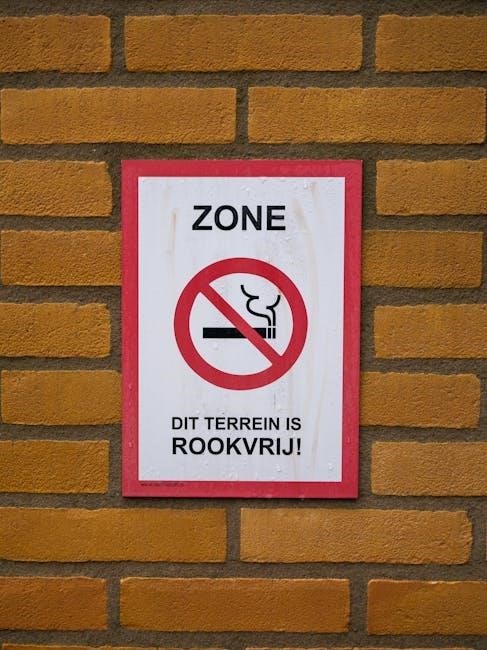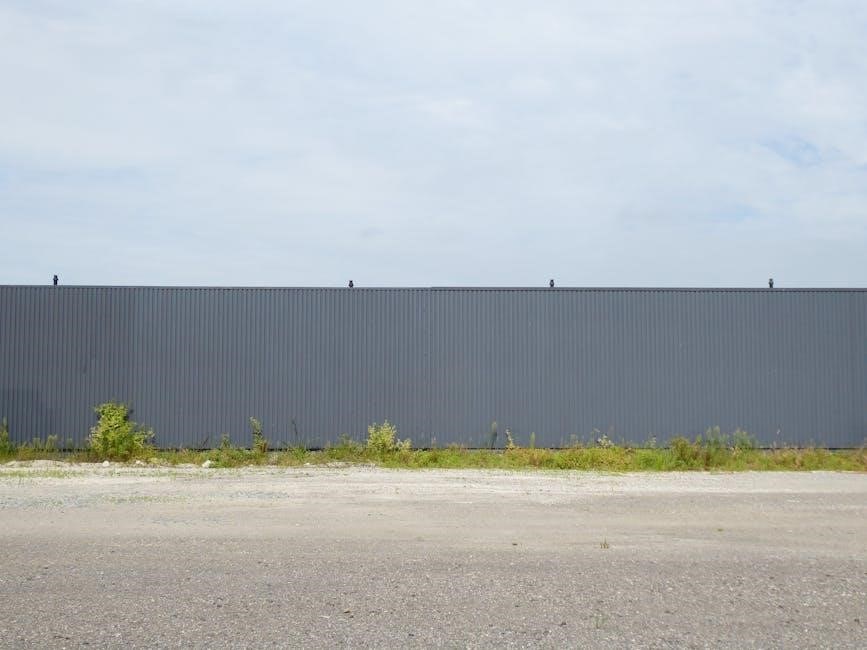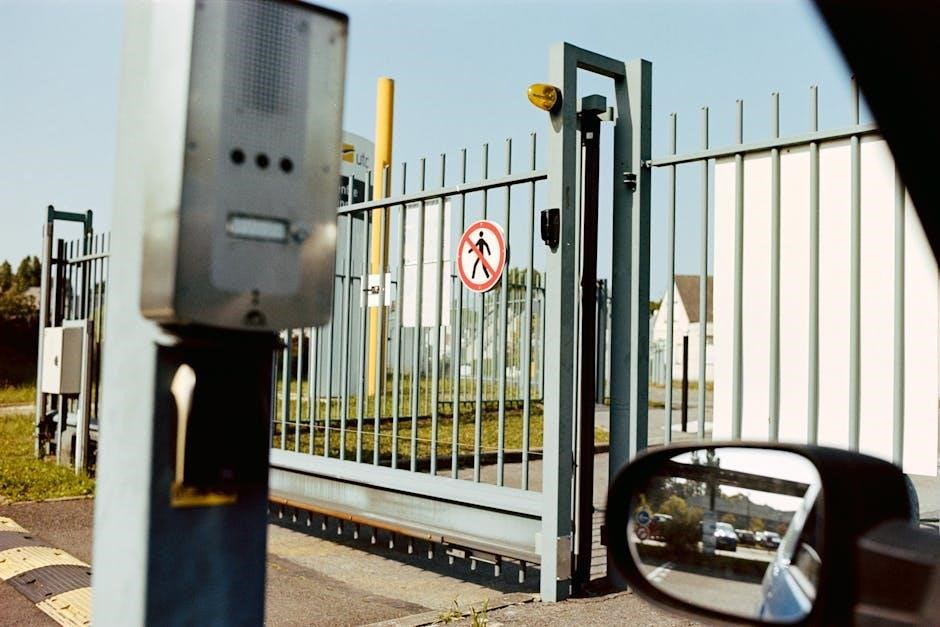Area and perimeter PDF worksheets are essential educational tools designed to help students, teachers, and parents practice and master geometry concepts through structured exercises and problems.
1.1 Importance of Area and Perimeter in Geometry
Understanding area and perimeter is fundamental in geometry, as these concepts form the basis for more complex calculations and real-world applications. The area of a shape measures the space inside it, while the perimeter represents the total length of its boundaries. These skills are essential for solving problems in architecture, design, and everyday situations, such as calculating room dimensions or material requirements. Mastering area and perimeter helps students build a strong foundation for advanced geometric concepts and develops their spatial reasoning abilities. These skills are critical for problem-solving in various fields, making them a cornerstone of early geometry education.
1.2 Overview of Printable PDF Worksheets
Printable PDF worksheets on area and perimeter offer a comprehensive and convenient way to practice geometry concepts. These resources are designed to cater to students of various grade levels, providing exercises tailored to their learning needs. From basic shapes like rectangles, squares, and triangles to more complex figures, the worksheets cover a wide range of problems. They include word problems, mixed exercises, and step-by-step solutions, ensuring a structured approach to learning. Many worksheets are free, making them accessible to everyone. Teachers and parents can use these PDFs to create engaging lessons, while students can practice independently to master area and perimeter calculations.

Key Concepts Covered in Worksheets
Worksheets cover fundamental concepts like area and perimeter formulas, calculations for basic shapes, and solving word problems, ensuring a solid foundation in geometric principles.
2.1 Understanding Area and Perimeter Formulas
Mastering area and perimeter formulas is crucial for solving geometric problems. The area of a shape, such as a rectangle, is calculated by multiplying its length and width, while the perimeter is the sum of all its sides. For squares, the area is the side length squared, and the perimeter is four times the side length. Triangles require knowing base and height for area (1/2 × base × height) and adding all three sides for perimeter. These foundational formulas are essential for more complex calculations and word problems, helping students build a strong understanding of spatial measurements and mathematical relationships.
2.2 Calculating Area and Perimeter for Basic Shapes
Calculating area and perimeter for basic shapes like rectangles, squares, and triangles is a fundamental skill in geometry. For rectangles, the area is found by multiplying length and width, while the perimeter is the sum of all sides. Squares, having equal sides, simplify calculations with area as side length squared and perimeter as four times the side length. Triangles require base and height for area (1/2 × base × height) and the sum of all three sides for perimeter. These exercises help students apply formulas to real-world problems, ensuring a solid grasp of spatial measurements and mathematical relationships.
2.3 Word Problems Involving Area and Perimeter
Word problems involving area and perimeter challenge students to apply mathematical concepts to real-world scenarios. These exercises often involve calculating the area or perimeter of objects like gardens, rooms, or fences. For example, determining the amount of paint needed to cover a wall or the cost of fencing a rectangular garden. Worksheets include problems with varying complexity, from simple calculations to multi-step scenarios. Students learn to interpret data, identify required measurements, and use formulas appropriately. These problems enhance critical thinking and problem-solving skills, bridging the gap between abstract formulas and practical applications. They are essential for developing a deeper understanding of how area and perimeter are used in everyday life.

Benefits of Using Area and Perimeter Worksheets
Area and perimeter worksheets enhance mathematical understanding, improve problem-solving skills, and provide practical applications of geometric concepts, making learning interactive and effective for students of all levels.
3.1 Reinforcing Mathematical Skills
Area and perimeter worksheets are invaluable for reinforcing foundational mathematical skills, ensuring students grasp key concepts through repetitive, structured practice. These exercises strengthen understanding of formulas, enabling accurate calculations for various shapes. By solving problems involving squares, rectangles, and triangles, students build confidence in applying geometric principles. The worksheets also introduce word problems, fostering the ability to translate real-world scenarios into mathematical equations. Regular practice with these resources helps students develop fluency in calculating areas and perimeters, laying a solid foundation for advanced geometric and algebraic studies. Clear, concise instructions and answer keys provide guidance, making these worksheets an essential tool for consistent skill improvement and mastery.
3.2 Developing Problem-Solving Abilities
Area and perimeter worksheets are designed to enhance problem-solving skills by presenting students with diverse challenges. These exercises encourage critical thinking, as students must apply formulas and geometric principles to solve complex problems. Word problems, in particular, require interpreting real-world scenarios, fostering the ability to translate descriptive information into mathematical solutions. Mixed operations and composite shapes further test analytical abilities, ensuring students can approach problems from multiple angles. The structured format of these worksheets allows students to refine their strategies, building confidence in tackling both routine and advanced mathematical challenges. By practicing these problems, students develop a systematic approach to problem-solving, essential for academic success and real-world applications.
3.4 Practical Application of Geometric Concepts
Area and perimeter worksheets bridge the gap between theoretical knowledge and real-world applications, enabling students to use geometric concepts in practical scenarios. These exercises help students visualize how area and perimeter calculations apply to everyday situations, such as designing rooms, planning gardens, or constructing buildings. By solving problems involving real-life objects, students develop a deeper understanding of spatial relationships and measurement techniques. This hands-on approach fosters the ability to apply mathematical skills to real-world challenges, making geometry more relatable and meaningful. The practical focus of these worksheets prepares students for future studies in architecture, engineering, and design, where area and perimeter calculations are essential.

Types of Exercises in Worksheets
Worksheets include exercises like calculating the area of rectangles, squares, and triangles, finding perimeters, mixed problems combining both, and more complex tasks involving word problems and composite shapes.
4.1 Calculating Area of Rectangles, Squares, and Triangles
These exercises focus on applying formulas to calculate the area of various shapes. For rectangles and squares, students use the formula Area = length × width. For triangles, the formula is Area = ½ × base × height. Worksheets include problems with integer and decimal measurements, ensuring a strong grasp of these fundamental concepts. Mixed units, such as inches, feet, and yards, are often incorporated to enhance real-world application skills. Visual aids and word problems are also included to make learning engaging and practical, helping students master the basics before progressing to more complex shapes and calculations.
4.2 Finding Perimeter of Various Shapes
This section focuses on calculating the perimeter of different shapes, starting with rectangles, squares, and triangles. For rectangles and squares, students apply the formula Perimeter = 2 × (length + width). For triangles, the perimeter is the sum of all three sides. Worksheets also introduce more complex polygons, requiring the addition of multiple side lengths. Exercises include problems with mixed units (inches, feet, yards) and word problems involving real-world scenarios. Visual aids and step-by-step solutions help students understand and apply the concepts effectively, building their confidence in calculating perimeters for various geometric figures. These exercises lay a strong foundation for tackling more complex shapes in later stages.
4.3 Mixed Problems Combining Area and Perimeter
Mixed problems challenge students to apply both area and perimeter concepts simultaneously. Worksheets include exercises where students might find a missing side length using the area and then calculate the perimeter, or vice versa. These problems often involve real-world scenarios, such as determining the amount of fencing needed for a garden or the carpeting required for a room. By combining both concepts, students develop a deeper understanding of how area and perimeter relate in practical applications. These exercises also enhance critical thinking and mathematical reasoning, preparing students for more complex geometry problems. The integration of area and perimeter reinforces foundational skills in a cohesive and engaging manner.

Worksheets for Different Grade Levels
Area and perimeter PDF worksheets cater to various grade levels, offering tailored exercises for 3rd-4th grades and advanced problems for 5th-6th grades, ensuring skill progression.
5.1 Area and Perimeter Worksheets for 3rd and 4th Grades
Area and perimeter worksheets for 3rd and 4th grades provide foundational exercises to introduce basic geometry concepts. These worksheets focus on simple shapes like rectangles, squares, and triangles, offering step-by-step problems to calculate area and perimeter. Students learn to apply formulas, such as area = length × width and perimeter = sum of all sides, through visual aids and practical examples. The exercises are designed to build confidence and fluency in math skills, with graduated difficulty to suit younger learners. Interactive activities, such as drawing shapes with specific measurements, make learning engaging and accessible. These resources are ideal for classroom use or homeschooling, ensuring a solid grasp of geometry basics.
5.2 Advanced Worksheets for 5th and 6th Grades
Advanced area and perimeter worksheets for 5th and 6th grades offer challenging exercises to deepen students’ understanding of geometry. These worksheets introduce complex shapes like circles, trapezoids, and composite figures, requiring the application of more sophisticated formulas. Word problems and real-world scenarios encourage critical thinking and practical application of skills. Students practice calculating area and perimeter for irregular shapes and mixed figures, enhancing their problem-solving abilities. Interactive activities, such as designing figures with specific measurements or solving multi-step word problems, make learning engaging. These resources are ideal for advanced learners or those needing extra challenges, providing a smooth transition to higher-level math concepts while reinforcing foundational skills.
Real-World Applications of Area and Perimeter
Area and perimeter concepts are vital in real-life scenarios, such as designing gardens, calculating room layouts, or estimating material costs, making them practical skills for everyday applications.
6.1 Using Area and Perimeter in Everyday Life
Understanding area and perimeter is crucial for real-world tasks, such as designing gardens, calculating room layouts, or estimating material costs for projects. For instance, determining the area of a floor helps in buying the right amount of carpet, while calculating the perimeter aids in fencing or framing. These skills are also useful in cooking, crafting, and construction, where precise measurements are essential. By mastering area and perimeter, individuals can tackle practical challenges more efficiently, making these concepts invaluable beyond the classroom. PDF worksheets provide ample practice, ensuring proficiency in applying these skills to everyday problems.
6.2 Practical Examples from Architecture and Design
In architecture and design, understanding area and perimeter is vital for creating functional and aesthetically pleasing spaces. For example, calculating the area of a room helps determine the amount of flooring needed, while perimeter measurements are essential for installing walls or fencing. Designers use these concepts to optimize layouts, ensuring efficiency and functionality. Additionally, architects rely on area and perimeter calculations to estimate material costs and structural requirements. PDF worksheets provide practical exercises that mirror real-world scenarios, helping professionals refine their skills and apply geometric principles effectively in their work. These examples highlight how area and perimeter are foundational to achieving design goals.

Interactive and Engaging Worksheet Activities
Interactive area and perimeter worksheets feature creative exercises like drawing figures with specific measurements and sorting shapes, making learning fun and engaging for students.
7.1 Drawing Figures with Specific Perimeter and Area
Drawing figures with specific perimeter and area is an engaging activity that enhances students’ understanding of geometric concepts. These exercises often require students to use graph paper to create shapes that meet given perimeter and area requirements. For example, students might be asked to draw a figure with a perimeter of 24 units or an area of 36 square units. This activity challenges students to think creatively and apply their knowledge of formulas in a practical way. It also helps students visualize how changes in side lengths can affect both the perimeter and area of a shape. Such tasks are ideal for developing spatial reasoning and problem-solving skills while making learning fun and interactive.
7.2 Sorting and Classifying Shapes by Properties
Sorting and classifying shapes by their properties is an interactive way to deepen students’ understanding of geometric concepts. Worksheets often include activities where students categorize shapes based on attributes like having a specific area, perimeter, or number of sides. For instance, students might group rectangles by their length-to-width ratios or identify shapes with the same perimeter but different areas. This activity enhances critical thinking and helps students recognize patterns and relationships between various properties. It also encourages visual differentiation, making it easier for students to apply these skills to real-world problems, such as designing spaces or calculating materials needed for projects.
Advanced Problems and Challenges
Advanced problems involve calculating area and perimeter of composite shapes and solving complex word problems with multiple steps, refining problem-solving skills for higher-level math challenges.
8.1 Calculating Area and Perimeter of Composite Shapes
Composite shapes, made by combining simpler shapes like rectangles and triangles, require breaking them into smaller parts to calculate their total area and perimeter. These exercises challenge students to apply their understanding of basic formulas to complex figures. By identifying and calculating the area and perimeter of each component, students refine their problem-solving skills and mathematical accuracy. This process also enhances spatial reasoning and the ability to visualize shapes in segments. Worksheets often include diagrams with measurements, allowing students to practice decomposition techniques and verify their results. Mastering composite shapes is crucial for advanced geometry and real-world applications, making these exercises invaluable for skill development.
8.2 Solving Complex Word Problems Involving Multiple Shapes
Complex word problems involving multiple shapes challenge students to apply their knowledge of area and perimeter to real-world scenarios. These exercises often require calculating the combined area or perimeter of various shapes, such as houses, gardens, or composite figures. Students must interpret the problem, visualize the shapes, and apply appropriate formulas. Worksheets include scenarios like designing a room with specific dimensions or calculating fencing for a garden with irregular boundaries. These problems enhance critical thinking and problem-solving abilities, preparing students for practical applications in architecture, engineering, and everyday life. By breaking down complex problems into manageable steps, students build confidence and mastery in geometry.
Area and perimeter PDF worksheets are invaluable tools for mastering geometry concepts. For further practice, explore additional resources like workbooks or video tutorials to reinforce learning and skill development.
9.1 Summary of Key Takeaways
Area and perimeter PDF worksheets are effective tools for mastering geometry concepts, offering a variety of exercises to suit different learning needs. These resources provide clear formulas and practical examples, helping students understand how to calculate the area and perimeter of basic shapes like rectangles, squares, and triangles. They also include word problems and mixed exercises to enhance problem-solving skills. Suitable for various grade levels, these worksheets cater to both beginners and advanced learners, ensuring a comprehensive understanding of geometric principles. Regular practice with these materials fosters mathematical fluency and prepares students for real-world applications of area and perimeter calculations.
9.2 Recommended Additional Practice Materials
Beyond area and perimeter PDF worksheets, students can benefit from interactive tools like online calculators and geometry software to visualize concepts. Video tutorials and guided lessons provide step-by-step explanations for complex problems. For hands-on learning, incorporating real-world projects, such as measuring rooms or designing gardens, can deepen understanding. Additionally, mobile apps and educational games offer engaging ways to practice area and perimeter calculations. Advanced learners can explore resources like “Area and Perimeter Riddles” or “Composite Shape Challenges” for a higher level of difficulty. Supplementing with textbooks or online courses can also reinforce mathematical skills and problem-solving abilities effectively.

